
8. Use safety accessories.
Safety glasses and earmuffs
should always be worn. A face or dust mask is
also required.
9. Connect dust extraction equipment.
If devices are
provided for the connection of dust extraction and
collection facilities, ensure that these are connected
and properly used.
10. Do not abuse the power cord.
Never pull the cord to
disconnect the tool from the power point. Keep the
cord away from heat, oil and sharp edges.
11. Secure the work piece.
Use clamps or a vice to hold
the work piece. It is safer than using your hand and
frees both hands to operate the tool.
12. Do not overreach.
Keep your footing secure and
balanced at all times.
13. Look after your tools.
Keep tools clean and sharp for
better and safer performance. Follow the instructions
regarding lubrication and accessory changes. Inspect
tool cords periodically and, if damaged, have them
repaired by an authorised service facility. Inspect
extension cords periodically and replace them if
damaged. Keep tool handles dry, clean and free from
oil and grease.
14. Disconnect idle tools.
Switch off the power and
disconnect the plug from the power point before
servicing, when changing accessories and when the
tool is not in use.
15. Remove adjusting keys and wrenches.
Form the
habit of checking to see that keys and adjusting
wrenches are removed from the tool before switching
it on.
16. Avoid unintentional starting.
Always check that the
switch is in the OFF position before plugging in the
tool to the power supply. Do not carry a plugged in
tool with your finger on the switch.
17. Use outdoor rated extension cords.
When a tool is
used outdoors, use only extension cords that are
intended for outdoor use and are so marked.
18. Stay alert.
Watch what you are doing. Use common
sense. Do not operate a power tool when you
are tired.
19. Check for damaged parts.
Before using a tool, check
that there are no damaged parts. If a part is slightly
damaged, carefully determine if it will operate
properly and perform its intended function. Check for
alignment of moving parts, binding of moving parts,
breakage of parts, proper mounting and any other
conditions that may affect the operation of the tool.
A part that is damaged should be properly repaired or
replaced by an authorised service facility, unless
otherwise indicated in this Instruction Manual.
Defective switches must be replaced by an authorized
service facility. Do not use a tool if the switch does
not turn the tool on and off correctly.
20. Guard against electric shock.
Prevent body contact
with grounded objects such as water pipes, radiators,
ranges and refrigerator enclosures.
21. Use only approved parts.
When servicing, use only
identical replacement parts. Use an authorised service
facility to fit replacement parts.
Warning.
The use of an accessory or attachment,
other than those recommended in this Instruction
Manual, may present a risk of personal injury.
5































